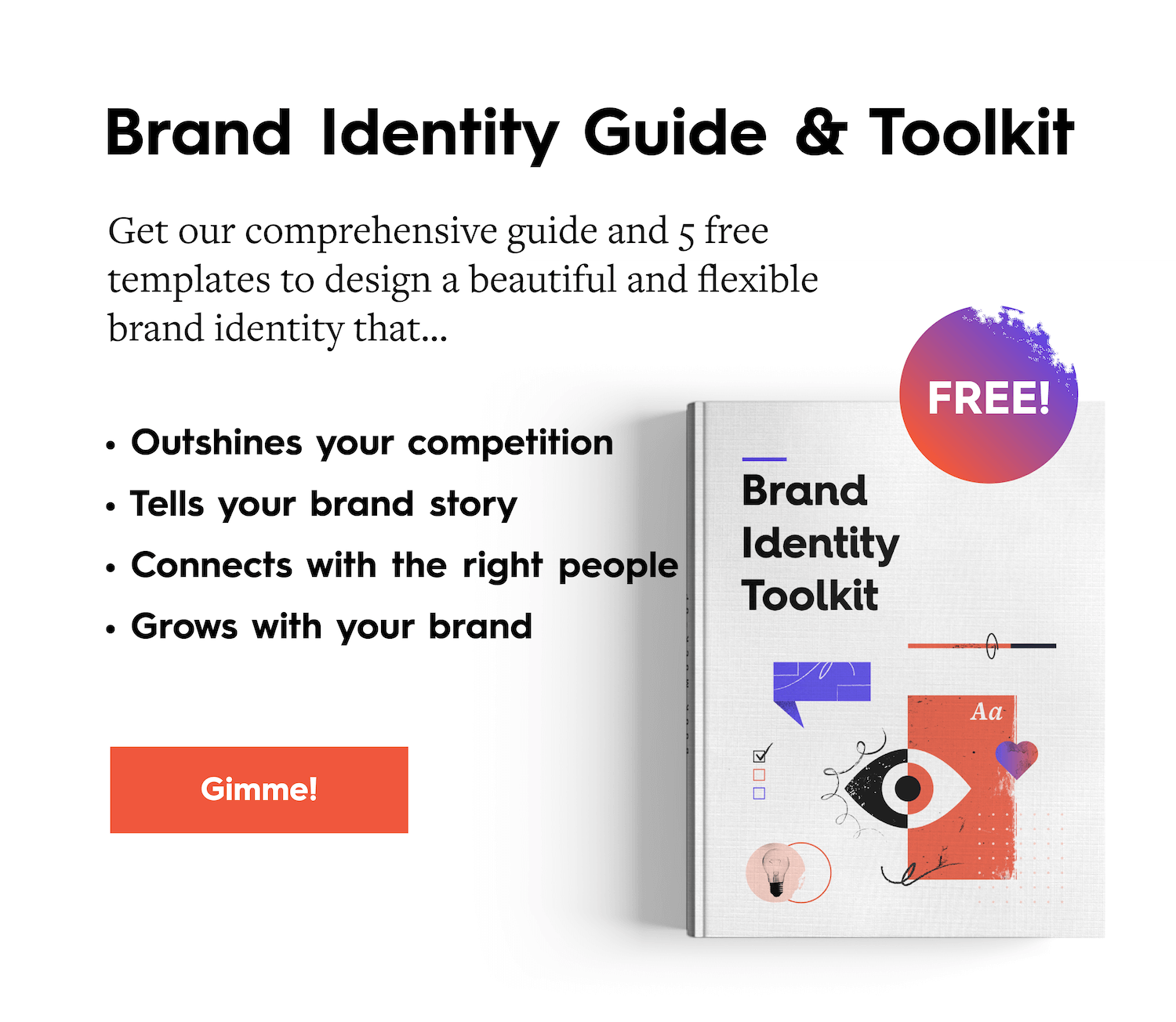A rebrand is an exciting venture for any organization, but the process can be painstaking and overwhelming. Where do you start? What do you tackle first? Who can help? It’s easy to find yourself paralyzed if you haven’t done it before.
Luckily, you don’t have to go it alone. We’ve helped many people rebrand, so we know what pitfalls and rebranding mistakes can sabotage the project—and we know how to avoid them. That’s why we’ve created a step-by-step process to get you through a rebrand from start to finish, including our best tips, tools, and templates. (It’s basically everything we wish we’d had when we started doing this work.)
How to Do a Rebrand
If you’re considering a rebrand, ready to start, or struggling because you’ve stalled out, we hope this guide helps you get through your rebrand as painlessly as possible.
But wait! Before you move on…
Download our free Brand Toolkit, which includes all of the tools and templates mentioned here. (Or, if you’re just working on one particular element, you can use the linked items for each step.)

If you’re ready to dive in, here’s what to do.
Step 1: Know why you’re doing a rebrand.
Just because you feel tired of looking at your logo doesn’t mean you need to dive into a rebrand. A rebrand takes a lot of time, energy, and resources, so it’s a decision that shouldn’t be made lightly. Every rebrand is different, but you should know exactly why you’re undertaking this venture.
Ultimately, you’re probably rebranding because there is a core problem with the way you’re communicating your brand. To remedy this effectively, you need to understand exactly what that problem is. Most importantly, you need to communicate that problem to your team so that everyone understands why they’re working toward this goal.
How to do it: Check out these 7 reasons to consider a rebrand. Have a discussion with your team to clarify why you’re doing it—and make sure everyone is on the same page.
Pro tip: Get buy-in at every stage of the process!
To complete a successful rebrand, you need everyone from your high-level decision-makers to your logo designer to be all in. To save headaches, get approval at every stage of the process. (Trust us, there’s nothing more frustrating than going back to square one because someone was left out of discussions.)
Step 2: Identify your brand team.
You need a team with the knowledge, expertise, and communication skills to pull off a rebrand, as there are a ton of moving parts and the process can get stressful pretty damn quickly.
When it comes to finding the right people to execute your rebrand, you can go entirely in-house or consider a brand agency. There are benefits to each, and it really just depends on what you need.
- In-house benefits: No one knows your brand like you do. If you have the knowledge, resources, and skills to tackle the rebrand yourself, you can certainly consider it.
- Branding agency benefits: While no one has as much intimate knowledge of your brand as you do, brands can sometimes function in a bubble. (Remember when Gap debuted a logo that only lasted a week?) Outside perspective can be tremendously valuable here. Branding agencies have plenty of expertise, they know what can go right and wrong, and they can steer you in the right direction.
Of course, doing a mix of both can also be beneficial. (We’ve collaborated with many brands to help them through the process—with great results.) No matter what team you work with, provide clear communication and cultivate creative collaboration.
How to do it: Follow our tips to build a brand team or find an agency that will be the right fit. Note: Giving your team the tools they need will help them move through this process much more smoothly. You might want to distribute this roundup of 101 tools for building a brand identity.
Step 3: Complete a competitive analysis.
Good branding is all about good communication—knowing both what to say and how to present yourself to your target customers, particularly in relation to other brands.
Hence, it’s helpful to analyze your competition by taking a critical look at every aspect of their brand, from logo design and tagline to brand voice and messaging. This is particularly useful information, as it reveals how you might zig where others zag. (You may be surprised by how many similarities you’ll see amongst your competitors. For example, if everyone uses a blue logo, you can make a statement with a different color.)
How to do it: Download our competitive analysis template to complete the exercise. Once completed, you should be able to identify opportunities to differentiate yourself.

Step 4: Know who you’re for.
You rebrand is about identifying who you are and communicating that effectively, but it’s also important to remember who you’re speaking to. While your target demo won’t entirely dictate your branding, you should consider how it may be perceived by them. At the end of the day, the true test of a rebrand is simple: Does it resonate with people or not?
How to do it: Download our free personas template to identify your audience. As you move through your process, consider your personas. Who are they? What do they want? How do they want to be spoken to? What do they want from your brand? These are valuable questions to ask.

Step 5: Complete a brand audit.
A good rebrand starts with good research. The more knowledge you have, the better your strategy and your creative approach will be. Before you officially start your rebrand (messaging, design, etc.), you need to understand what’s working, what’s not, how you need to grow, etc. In short, you need to understand the current state of your brand, then adjust accordingly.
Thus, a brand audit is the crucial first step. Similar to your competitive analysis, this is an opportunity to do a deep dive into your own brand—as it stands now. The insights gathered during this stage will influence your decision-making going forward.
How to do it: Download our Rebrand Questionnaire, and follow our step-by-step guide to complete a brand audit.

Once you’ve done a thorough brand audit, you should know what areas need the most immediate help. The instinct may be to dive into these all at once, but keep in mind that your brand is a complex ecosystem. You can’t just change a tagline and order a thousand new business cards and call it a day.
Note: A strong brand is crafted with thought and intention, and each element relies on the other. That’s why we have arranged the following steps in a particular order. You may not need to spend as much time on each step, but you should approach it the way we’ve laid it out.
Step 6: Articulate your brand heart.
What is your Brand Heart? It’s an articulation of who your brand is—at its core. More specifically, your Brand Heart is comprised of your:
- Purpose: Why do you exist?
- Vision: What future do you want to help create?
- Mission: How do you create that future?
- Values: Who are you? How do you work?
These elements will influence every aspect of your rebrand. Thus, you need to make sure each is clearly documented. You might find that you have a partial version of your Brand Heart articulated, but this is the time to reevaluate and make sure it accurately reflects who you are and what you’re trying to achieve going forward.
How to do it: Use our Brand Heart workbook to articulate your purpose, vision, mission, and values.
Pro tip: Provide transparency into the process.
It seems obvious, but transparency helps everyone from your designer, to project manager, to CMO understand exactly what’s happening, who’s handling it, and what is expected. Clear, concise documentation of everything, from your Brand Heart and timeline to budget and brand audit questionnaire, is tremendously helpful. Your project manager should be in charge of keeping research organized, documents updated, and everything stored in an easy-to-access place.
Step 7: Clarify your brand messaging.
You might be tempted to dive into your logo design or visual assets first, but remember that your visual identity is an extension of your messaging. Thus, it’s important to articulate your brand messaging first, including your:
- Brand essence (voice, tone, personality)
- Tagline
- Value prop
- Brand messaging pillars
These messaging elements can become stale over time, especially if it’s been decades since you rebranded. Your goal is to create messaging that is consistent, cohesive, and aligned to your brand goals.
How to do it: You may need to start from scratch or refine your existing brand messaging. For more help in doing it, follow our guides to:
- Write an effective tagline.
- Write a strong value proposition.
- Complete your brand messaging.
- Find your brand voice.
- Discover your brand personality.
Step 8: Design your visual identity.
When most people think about doing a rebrand, they think about a brand’s visual identity, focusing only on what it looks like. But, again, your visual identity is simply a reflection and extension of who and what your brand is, which is why it’s important to have those locked before you tackle this step.
That said, your visual identity is the “face” of your brand, so it should represent you well at every touchpoint. To do this effectively, you need to design an identity that is:
- Comprehensive: It should empower designers to create all sorts of content, whether it’s a motion graphic on your website or a banner at a trade show.
- Flexible: It should work across mediums, and be able to evolve as your brand grows.
- Intuitive: Each element should work together.
- Accurate: It should communicate your brand personality effectively.
That means that certain elements may need to be revised, updated, or added to your existing visual identity, including things like:
- Colors
- Logo
- Typography
- Hierarchy
- Photography
- Illustration
- Iconography
- Data visualization
- Interactive elements
- Video and motion
- Etc.
It’s also important to approach your visual rebrand from the top down, as different elements influence each other, such as logo and color.
How to do it: To design a strong visual identity, follow these tips to create a memorable brand identity, use our handy visual identity checklist, and get inspired by these awesome examples of successful rebrands.
Step 9: Create your brand guidelines.
Some teams are resistant to or overwhelmed by change; you can’t just introduce the new branding and leave them to their own devices. You need to empower your team to apply branding correctly by presenting it all—your Brand Heart, messaging, and visual identity—in nice, neat guidelines.
To make things easier, provide comprehensive and easy-to-understand directions, along with things like real-world examples or checklists to make it foolproof. Your updated guidelines should be accessible and available to any content creator who needs them, and you also should designate a point person to answer any questions about how to apply them.
How to do it: Follow our tips to create a brand style guide that everyone can use.
Step 10: Roll out your branding.
Completing a rebrand is one thing; releasing it into the world is another. From briefing your team to announcing it to the press, there are a lot of things to think about. The better prepared you are, the more smoothly things will go. Thus, you should have a solid rollout strategy, both internally and externally.
How to do it: Try these tips to help get everyone ready and onboard.
Support Your Team Along the Way
It’s easy to feel stressed during the rebrand process, but remember you can do it, get through it, and come out with a better brand in the end. This work is vital to shepherd your brand into the future, but it doesn’t stop once you introduce your new branding to the world. It’s only the jumping-off point. Now you have an opportunity to bring your brand to life at every possible touchpoint.
Once you’re done celebrating the end of a long and arduous process, you can put your new branding to work in many ways:
- Refine your content strategy to ensure it’s aligned to your new branding.
- Learn how to tell your brand story in unique ways.
- Optimize your content creation process to create high-quality content as effectively as possible.
- Track your results to find out how it’s working—and how you can continue to improve.
But if you’re feeling stuck at any stage (or aren’t sure how to proceed), don’t get overwhelmed. Hit us up if you think you could use some extra hands. We’d love to help tell your brand story in any capacity.






but how do you make the new logo I need help pls
Very good articulate step by step guide and tools on how to conduct a rebrand.
This is very impressive
That’s great to hear. Thanks.